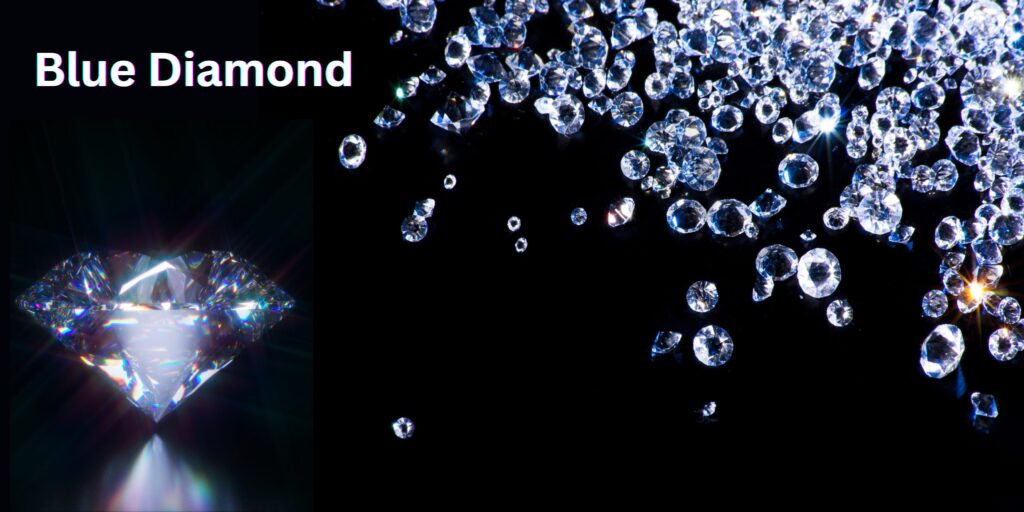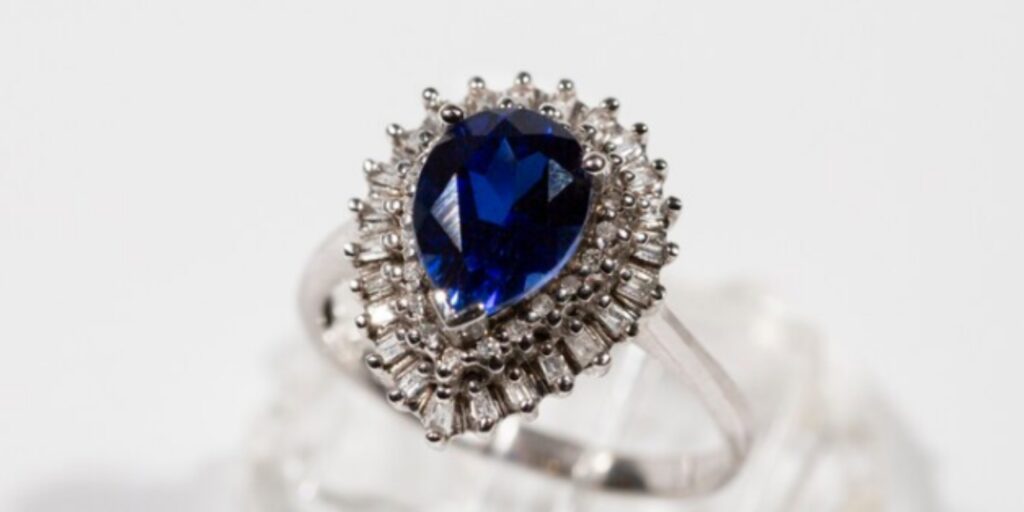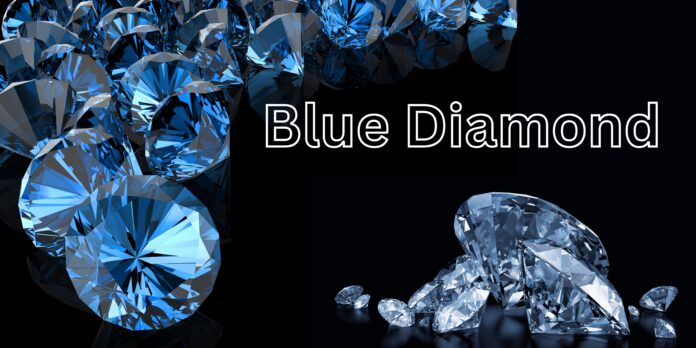Table of Contents
Introduction: Blue Diamonds
Blue diamonds are among the rarest and most exquisite gemstones in the world, renowned for their unparalleled beauty and staggering prices. Why are blue diamonds so expensive? What makes them more valuable than other diamonds? We will dive deep into the reasons behind the exciting price tags of blue diamonds, exploring everything from their rarity and the unique factors affecting their cost to their historical significance.
What Are Blue Diamonds?
Blue diamonds are a unique type of diamond that exhibits a mesmerizing blue hue due to the presence of trace amounts of boron in their crystal lattice. These diamonds fall under the fancy-colored diamond category and are graded based on the intensity of their color, which can range from faint blue to deep, vivid shades.
Are Blue Diamonds Authentic?
Yes, blue diamonds are real and incredibly rare gemstones that exist in nature. Unlike traditional colorless diamonds, blue diamonds derive their stunning hue from the presence of boron, a trace element that interacts with the diamond’s carbon structure. This unique element absorbs certain wavelengths of light, allowing the blue color to stand out. The rarity of blue diamonds makes them highly coveted in the jewelry market, with their price often reflecting their scarcity.
What Makes Blue Diamonds Different?
Before understanding why blue diamonds are so expensive, it’s important to know what sets them apart from other diamonds. While most diamonds are colorless, blue diamonds get their rich hue from trace elements, primarily boron, which gives them their distinct blue coloration.

The Science Behind Blue Diamonds
The Formation Process
Unlike regular diamonds, blue diamonds form under extremely rare conditions deep within the Earth’s mantle. The presence of boron, which combines with carbon during diamond formation, gives these gemstones their distinctive blue color.
The Role of Boron
Boron atoms absorb light in the red, yellow, and green regions of the spectrum, allowing the blue light to shine through. This unique interaction is responsible for the captivating blue shades found in these diamonds.
Rarity of Blue Diamonds
Limited Occurrences
Blue diamonds are incredibly scarce, accounting for less than 0.02% of all mined diamonds. Their primary sources are select mines, including the Cullinan mine in South Africa and, historically, the Golconda mines in India.
Natural vs. Treated Blue Diamonds
While some diamonds can be artificially treated to mimic the color of natural blue diamonds, genuine stones are much rarer and hold significantly higher value. Natural blue diamonds remain the pinnacle of exclusivity.
Key Factors Contributing to the High Price of Blue Diamonds
Several factors contribute to the high price of blue diamonds. These include their rarity, the complexity of their formation, demand, and the involvement of specialized cutting techniques.
1. Rarity and Limited Sources
The rarity of blue diamonds is one of the most critical factors that drive up their price. Blue diamonds are not commonly found in nature, and the primary source of blue diamonds has been the Argyle mine in Australia, which closed in 2020. As a result, the global supply of blue diamonds has become even more restricted, pushing their prices higher.
Other sources of blue diamonds, such as mines in South Africa and India, also have limited yields. The Argyle mine was responsible for the bulk of the world’s supply of blue diamonds, and with its closure, the availability of these precious stones is now more limited than ever.
2. The Cost of Extraction and Mining
Extracting blue diamonds is far more complex and costly than mining regular white or colorless diamonds. The rare occurrence of blue diamonds within the earth’s crust makes them difficult to find, requiring advanced mining technology and techniques to unearth them. The cost of extracting these diamonds is passed on to consumers in the form of higher prices.
Due to their rarity, many blue diamonds are found in smaller sizes, which makes their extraction even more costly. Larger blue diamonds, especially those with significant carat weight, are even more expensive due to the higher extraction cost and their rarity.
3. Unique Characteristics of Blue Diamonds
Blue diamonds are not just rare, but they also possess unique characteristics. The specific shade of blue, known as “fancy blue,” ranges from light blue to deep, intense blue hues. Some blue diamonds also display secondary colors, such as violet or green, which can further affect their value. The intensity of the blue color, known as the “fancy color” grading, plays a significant role in determining the price of the diamond. The more vivid the blue, the more valuable the diamond.
4. Historical Significance and Demand
Blue diamonds have also been associated with history and royalty. Famous blue diamonds such as the Hope Diamond, the Blue Moon Diamond, and the Tiffany Blue Diamond have given blue diamonds an air of prestige and luxury. These diamonds have made blue diamonds highly desirable among collectors, investors, and high-net-worth individuals, which has contributed to their increasing value.
Understanding Blue Diamond Pricing
When it comes to blue diamond pricing, several factors come into play. To rarity, color, and size, other considerations, such as the diamond’s cut, clarity, and overall market demand, all influence the price. Let’s take a closer look at how much a blue diamond can cost and what factors determine their market value.
How Much Is a Blue Diamond Worth?
Blue diamonds are generally much more expensive than traditional colorless diamonds due to their rarity and unique characteristics. On average, blue diamonds can range from $3,000 to $5,000 per carat, but prices can skyrocket depending on factors such as the color saturation, the size of the diamond, and its provenance.
A blue diamond with a lighter hue will typically cost less than one with a deep, intense blue color. A blue diamond of higher clarity and larger size can command higher prices even if the color is not as saturated. The pricing is also affected by the diamond’s cut and the overall quality of the stone.
Blue Diamond Cost: Examples from the Market
- Smaller Blue Diamonds (Under 1 Carat): These diamonds may cost anywhere between $2,000 to $6,000 per carat, depending on factors like color intensity and clarity.
- Medium to Large Blue Diamonds (1-3 Carats): Larger blue diamonds can range from $10,000 to $100,000 or more per carat, especially if the color is vivid and the clarity is high.
- Rare and Exceptional Blue Diamonds (Over 3 Carats): Exceptional stones, such as those with rare shades or impressive sizes, can be priced upwards of $200,000 per carat or even higher.
The Most Expensive Blue Diamond Rings
The most expensive blue diamond rings are often found in the high-end jewelry market, worn by royalty or celebrities. These rings are often custom-designed and feature flawless diamonds that showcase the blue diamond’s unique color and clarity.

Famous Blue Diamond Rings
- The Tiffany Blue Diamond Ring: This iconic ring, featuring a 9.75-carat cushion-cut blue diamond, is estimated to be worth over $20 million. Tiffany’s reputation for exceptional quality, paired with the extraordinary beauty of the diamond, has made this ring one of the most famous blue diamond rings in the world.
- The Hope Diamond: While not a ring, the Hope Diamond is one of the most famous blue diamonds globally. Weighing 45.52 carats, the Hope Diamond is one of the most valuable gemstones, with an estimated value of over $200 million.
- The Blue Moon Diamond Ring: A 12.03-carat blue diamond ring, sold for a record-breaking $48.5 million at auction in 2015. This diamond was a rare and flawless stone with a vivid blue hue, making it one of the most expensive blue diamonds ever sold at auction.
Why Are These Rings So Expensive?
The high cost of blue diamond rings can be attributed to the quality of the stones and the rarity of blue diamonds. As mentioned, blue diamonds of exceptional size, color, and clarity are scarce, making them highly desirable to collectors. The artistry and craftsmanship of the setting also contribute to the overall value of the ring.

The Most Expensive Blue Diamond Ever Sold
The Blue Moon Diamond
The most expensive blue diamond ever sold is the Blue Moon Diamond, a rare and flawless 12.03-carat blue diamond that sold for $48.5 million at an auction in 2015. This diamond set a new record for the price of a blue diamond per carat, which came to approximately $4 million per carat. The Blue Moon Diamond’s rich color and rare size made it a once-in-a-lifetime gemstone, and its sale highlighted the incredible demand for blue diamonds.
How to Care for Blue Diamonds
Proper Storage
Store your blue diamond jewelry in a soft, padded box to prevent scratches or damage.
Regular Cleaning
Clean your diamonds with a mild soap solution and a soft brush to maintain their sparkle. Avoid harsh chemicals that could harm the stone.
Professional Maintenance
Have your blue diamond pieces inspected by a jeweler periodically to ensure the settings remain secure.
Famous Blue Diamonds
The Hope Diamond
Weighing an impressive 45.52 carats, the Hope Diamond is one of the most famous blue diamonds in the world. Its exceptional color and storied history have made it an iconic symbol of luxury and mystique.
The Blue Moon Diamond
Discovered in the Cullinan mine, the Blue Moon Diamond is renowned for its vivid color and impeccable quality. It was sold for a record-breaking price at auction, underscoring its extraordinary value.
Other Notable Examples
Other famous blue diamonds include the Wittelsbach-Graff Diamond and the Bulgari Blue, each carrying unique characteristics and histories that add to their allure.
Why Are Blue Diamonds So Expensive?
1. Rarity
The limited availability of natural blue diamonds drives up their value. Their rarity makes them a status symbol for wealth and exclusivity.
2. Exquisite Beauty
The enchanting blue hues of these diamonds make them stand out among other gemstones. This exceptional aesthetic appeal further contributes to their high price.
3. Symbolism
Blue diamonds are often associated with royalty, power, and timeless elegance, making them a desirable choice for those looking to make a statement.
4. High Demand in the Market
Collectors, investors, and luxury enthusiasts worldwide actively seek out blue diamonds, creating a competitive market that pushes their prices even higher.
Investing in Blue Diamonds
Factors to Consider
When investing in blue diamonds, it’s essential to evaluate factors such as color, carat weight, clarity, and origin. Certified diamonds with documented histories often command higher prices.
Long-Term Value
Blue diamonds have consistently appreciated in value over the years, making them a sound investment. Their rarity and demand ensure they remain a lucrative asset.
Conclusion
Blue diamonds are a testament to nature’s incredible artistry, blending rarity, beauty, and value into a single gemstone. Their high price is a reflection of their exceptional qualities, from their unique formation process to their unparalleled aesthetic appeal. Whether you are a collector, investor, or enthusiast, blue diamonds offer a captivating glimpse into the world of luxury and exclusivity. If you’re looking to own a piece of history and elegance, blue diamonds remain an unmatched choice.
FAQ’s
Q1. Why are blue diamonds so expensive?
Blue diamonds are expensive due to their rarity, the complexity of their formation, and the costs associated with extracting them from the earth. Their stunning color, which is caused by the presence of boron, adds to their desirability and high price.
Q2. How much is a blue diamond worth?
A blue diamond can range from $3,000 to $5,000 per carat, but prices can be significantly higher depending on the size, color intensity, and clarity. Rare and exceptional blue diamonds can fetch much higher prices, especially in the case of large, flawless stones.
Q3. What is the most expensive blue diamond ring?
The most expensive blue diamond ring is the Tiffany Blue Diamond Ring, which features a 9.75-carat cushion-cut blue diamond and is valued at over $20 million.
Q4. What is the most expensive blue diamond?
The Blue Moon Diamond is the most expensive blue diamond ever sold. This 12.03-carat stone fetched $48.5 million at auction, setting a record for blue diamonds.
Q5. What factors determine the price of a blue diamond?
The price of a blue diamond is determined by factors such as color intensity, size, clarity, and the diamond’s provenance. Rarity and market demand also play significant roles in determining the cost.



Thank you for your sharing. I am worried that I lack creative ideas. It is your article that makes me full of hope. Thank you. But, I have a question, can you help me?
Thank you so much for your kind words that really means a lot. I’m glad the article gave you hope and inspiration! Of course, feel free to ask your question, I’m here to help.
I needed to create you one little word to finally thank you as before for your personal magnificent tricks you’ve documented at this time. It is certainly generous of you to deliver publicly what exactly a lot of folks would’ve offered for sale for an e-book to get some bucks on their own, particularly considering the fact that you might well have tried it in case you considered necessary. These suggestions also acted to become a fantastic way to be certain that other individuals have the same desire just like my very own to figure out great deal more in terms of this matter. I know there are a lot more pleasurable situations up front for many who read your website.
Thank you so much! I truly appreciate your kind words. I’m glad the tips were helpful, and it means a lot to know they made a difference. Wishing you all the best! 😊
Your article helped me a lot, is there any more related content? Thanks!
Thanks
You have mentioned very interesting points! ps decent site.
very good put up, i certainly love this website, carry on it
Good day! Do you know if they make any plugins to safeguard against hackers? I’m kinda paranoid about losing everything I’ve worked hard on. Any recommendations?
Yes, there are great plugins to protect your site! Try Wordfence, Sucuri, or iThemes Security. They help block hackers, scan for malware, and secure logins. Always keep everything updated and use strong passwords!
I think this is one of the most important information for me. And i am glad reading your article. But wanna remark on few general things, The site style is perfect, the articles is really excellent : D. Good job, cheers
Hi there! This post couldn’t be written any better! Reading through this post reminds me of my previous room mate! He always kept talking about this. I will forward this article to him. Pretty sure he will have a good read. Thank you for sharing!
magnificent post, very informative. I wonder why the other specialists of this sector do not notice this. You should continue your writing. I am confident, you have a great readers’ base already!
Outstanding post, you have pointed out some excellent details , I likewise believe this s a very good website.
Exactly what I was searching for, regards for posting.
Wonderful items from you, man. I have keep in mind your stuff previous to and you’re simply extremely fantastic. I actually like what you’ve obtained right here, really like what you’re stating and the way during which you say it. You are making it enjoyable and you still care for to stay it sensible. I cant wait to learn far more from you. This is actually a wonderful website.
I appreciate, cause I discovered just what I was taking a look for. You’ve ended my four day long hunt! God Bless you man. Have a great day. Bye
Thank you for sharing with us, I conceive this website truly stands out : D.
I am continually invstigating online for ideas that can benefit me. Thx!
Hello.This post was extremely interesting, especially since I was browsing for thoughts on this topic last Thursday.
I got good info from your blog
Glad to be one of several visitors on this awful internet site : D.
WONDERFUL Post.thanks for share..more wait .. …